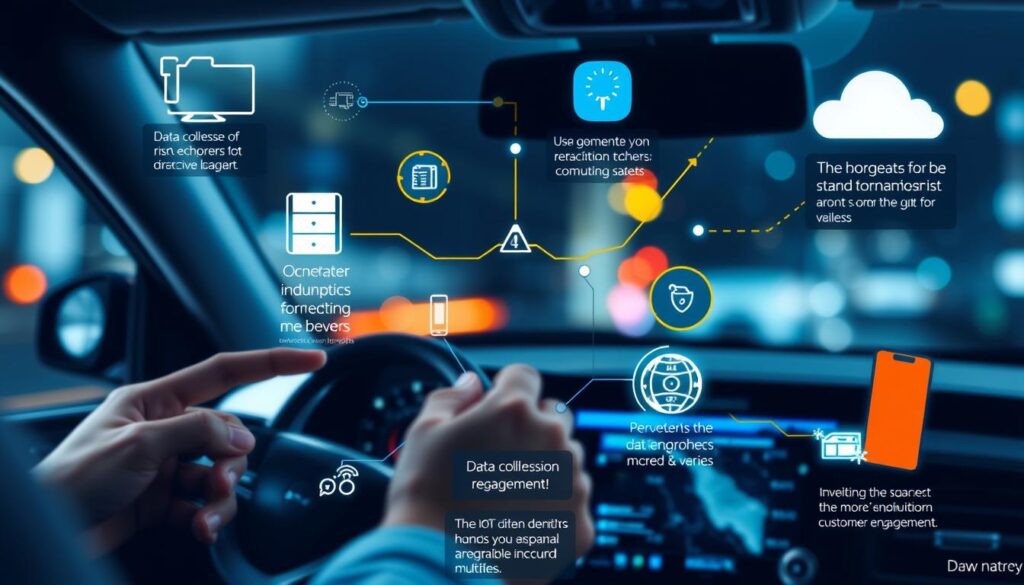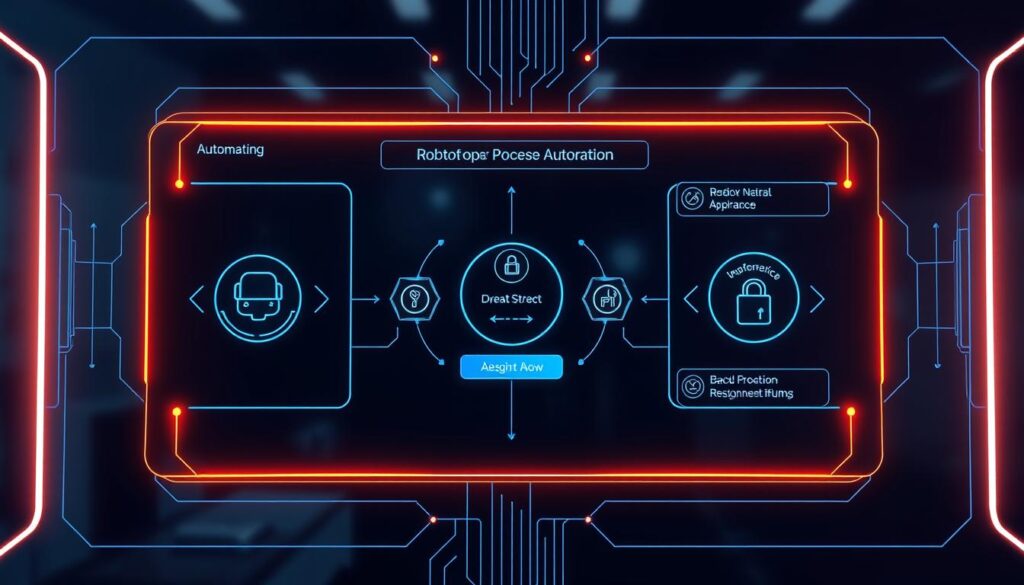The insurance industry is undergoing a significant transformation, driven by technological advancements. A staggering 95% of insurance executives believe that data analytics will be crucial to the industry’s innovation over the next three years.
At CoWrit Technologies Inc., we’re excited to explore how these advancements are reshaping the insurance industry. With 62% of executives confident that the industry is keeping pace with technology, it’s clear that insurance companies are embracing innovation to enhance customer experience.
Key Takeaways
- The insurance industry is being transformed by technological advancements.
- Data analytics is expected to play a crucial role in the industry’s innovation.
- Insurance companies are embracing innovation to enhance customer experience.
- The industry is keeping pace with technology, with 62% of executives expressing confidence.
- Insurtech advancements are driving significant change in the insurance landscape.
The Evolution of Insurance Technology
As we explore the insurance industry’s journey, it’s clear that technology has played a pivotal role in its transformation. The insurance industry, once characterized by traditional methods, has undergone significant changes with the advent of insurtech.
The shift from traditional to digital has been remarkable. Initially, the focus was on making insurance more accessible through online platforms. This allowed customers to compare quotes and purchase policies directly, enhancing customer experience and streamlining operations.
From Traditional Methods to Digital Transformation
The insurance industry has moved from manual processes to sophisticated digital solutions. The introduction of big data, analytics, and artificial intelligence (AI) has accelerated innovation, enabling personalized risk assessment and faster underwriting. Advanced claims management via chatbots has also improved customer service.
The Growth of the Insurtech Market
The insurtech market has experienced significant growth, valued at 49.82 billion U.S. dollars in 2024 and expected to reach 66.66 billion U.S. dollars by 2029. This growth reflects the increasing adoption of technology across the insurance value chain.
| Year | Market Value (Billion U.S. Dollars) |
|---|---|
| 2024 | 49.82 |
| 2029 | 66.66 |
This evolution has fundamentally changed how insurance companies assess risk, process claims, and interact with customers. The insurance industry continues to transform, driven by technological advancements and changing customer expectations.
Why Insurtech Matters in Today’s Insurance Landscape
In today’s insurance landscape, insurtech is no longer a niche concept, but a vital component of the industry’s growth. The insurance industry is facing a significant shift, driven by changing customer expectations and the need for operational efficiency. As a result, insurers are turning to insurtech to stay competitive.
Customers today expect a seamless digital experience when interacting with insurance companies. They demand more analytics on their data and a streamlined process from obtaining quotes to filing claims. To meet these expectations, insurers are embracing technology, including AI-powered underwriting and blockchain-based security.
Meeting Changing Customer Expectations
Today’s insurance customers expect digital-first experiences that offer convenience, transparency, and personalization. Insurtech solutions are helping insurers bridge this gap by providing the tools and technologies needed to create seamless customer journeys. By leveraging insurtech, insurers can improve customer satisfaction and enhance the overall customer experience.
For instance, insurtech companies are developing innovative products that cater to individual customer needs. This personalized approach enables insurers to better serve their customers and stay ahead in the competitive insurance market.

Driving Operational Efficiency and Cost Reduction
Insurtech is not only improving customer experiences but also driving operational efficiency through automation, reducing manual processes, and streamlining workflows across the insurance value chain. By implementing insurtech solutions, insurers can lower administrative expenses, reduce claim processing times, and achieve more accurate risk assessment.
These efficiency gains translate into competitive advantages for insurers who embrace technology, allowing them to offer better pricing and service to their customers. As the insurtech space continues to attract new entrants, traditional players are under pressure to innovate or risk losing market share to more agile, tech-savvy competitors.
By understanding the trends and innovations in insurtech, insurers can identify potential possibilities and risks, ultimately staying ahead in the evolving insurance industry.
Emerging Trends in Insurtech Reshaping the Industry
As we navigate 2024, it’s clear that insurtech is not just a peripheral aspect of the insurance industry, but a driving force behind its transformation. The first half of 2024 has witnessed significant strides in technological adoption, reflecting the industry’s commitment to innovation and enhanced customer experiences.

The Acceleration of Digital Adoption Post-2020
The COVID-19 pandemic served as a catalyst for digital adoption in the insurance sector, accelerating transformation initiatives that might otherwise have taken years to implement. This acceleration has changed insurers’ priorities and investment strategies, with a greater focus on digital capabilities and remote service delivery. As a result, the insurance industry has seen a significant shift towards digitalization, with insurers leveraging technologies like AI, blockchain, and IoT to improve operational efficiency and customer engagement.
The pandemic highlighted the need for insurers to be agile and responsive to changing customer needs. In response, many insurers have invested heavily in digital transformation, implementing new technologies and processes to enhance customer experiences and improve operational efficiency.
Key Market Indicators and Growth Projections
The U.S. insurtech market size is valued at 49.82 billion U.S. dollars in 2024 and is expected to reach 66.66 billion U.S. dollars by 2029, demonstrating a strong growth trajectory. The global predictive analytics market is also expected to grow to USD 21.5 billion by 2025, at a CAGR of 24.5%. These growth projections indicate a significant opportunity for insurers to leverage insurtech to drive innovation and growth.
Key market indicators, including investment trends, adoption rates, and consumer behavior shifts, demonstrate the growing importance of insurtech in the insurance industry. As the industry continues to evolve, we can expect to see new trends and technologies emerge, further transforming the insurance landscape.
Our analysis will continue to explore how these trends are influencing insurers’ strategic planning and technology roadmaps, and how emerging technologies are converging to create new possibilities for insurance products, services, and business models.
AI and Machine Learning Integration

The advent of AI and machine learning is transforming the insurance landscape, offering unprecedented opportunities for efficiency and accuracy. These technologies are enhancing various aspects of the insurance process, from underwriting and claims processing to customer service.
Revolutionizing Underwriting Processes
AI is revolutionizing underwriting processes by analyzing vast datasets to identify patterns and risk factors that human underwriters might miss. This leads to more precise risk assessments and personalized pricing models for insurance policies. By leveraging machine learning algorithms, insurers can process applications faster while maintaining or improving the quality of risk evaluation.
Enhanced Fraud Detection Capabilities
Machine learning algorithms are revolutionizing fraud detection by identifying suspicious patterns and anomalies in claims data. These advanced systems constantly analyze information to detect fraudulent activity in real-time, saving insurers millions while ensuring legitimate claims are processed efficiently.
AI-Powered Customer Service
AI-powered chatbots and virtual assistants are transforming the customer experience by providing instant, 24/7 support. These AI applications are not only automating routine tasks but are also becoming increasingly sophisticated in handling complex customer interactions, making the insurance process more efficient and customer-friendly.
As we continue to integrate AI and machine learning into the insurance industry, it’s crucial to address the challenges and considerations, including data quality issues and the need for human oversight. By doing so, insurers can fully leverage these technologies to improve their operations and better serve their customers.
Generative AI: The New Frontier in Insurance

The insurance industry is on the cusp of a revolution with the advent of generative AI. Since 2023, generative AI has gone mainstream in all industries, and insurance is no exception. Generative AI tools like Gemini and ChatGPT help insurers automate repetitive tasks, including underwriting, claims technology, fraud detection, and customer support.
Insurance sector leaders are leveraging generative AI to reduce costs, create new business models, and improve the value of existing services. For instance, knowledge assistants dramatically reduce the time needed to access and interpret policy documents. The market of generative AI is experiencing rapid growth, with projections estimating that it will reach $22.12 billion by 2025, growing at a compound annual growth rate (CAGR) of 27.02%.
Automating Document Processing and Policy Creation
Generative AI is being used to automate document processing, including policy creation, claims documentation, and regulatory filings. These tools are dramatically reducing the time and resources required for document-intensive processes while improving accuracy and consistency.
By automating these tasks, insurers can focus on higher-value activities such as customer service and risk assessment. This not only enhances operational efficiency but also leads to cost savings and improved customer satisfaction.
Real-World Applications and Success Stories
Several insurers have already begun implementing generative AI solutions with significant success. For example, some companies are using generative AI to enhance customer communications, personalize policy offerings, and streamline underwriting decisions.
These real-world applications demonstrate the potential of generative AI to transform the insurance industry. As the technology continues to evolve, we can expect to see even more innovative applications and success stories emerge.
Blockchain Technology for Transparency and Security

The integration of blockchain technology is set to revolutionize the insurance industry by providing unprecedented levels of transparency, security, and efficiency. Blockchain’s distributed ledger technology creates an immutable record of transactions that can transform how insurance contracts are created, managed, and executed.
We will explore how blockchain technology is revolutionizing insurance operations. Key aspects include the implementation of smart contracts in claims processing and enhanced data security and privacy protection.
Smart Contracts in Claims Processing
Smart contracts operate on the blockchain, executing automatically when predefined conditions are met. This reduces the need for intermediaries, speeds up processes, and minimizes the potential for human error. By automating claims processing, insurers can reduce processing times from weeks to minutes, minimizing disputes and improving customer satisfaction.
The use of smart contracts in claims processing eliminates the need for manual verification and approval, making the process more efficient. This not only benefits insurers but also enhances the overall customer experience.
Enhanced Data Security and Privacy Protection
Blockchain technology strengthens protection for sensitive customer data and guarantees adherence to data privacy rules within the insurance technology industry. By creating secure, encrypted records that can only be accessed by authorized parties, blockchain enhances data security and privacy protection.
This improved security posture helps insurers comply with increasingly stringent data protection regulations while building trust with customers. Moreover, blockchain creates a transparent and unalterable record of claims history, reducing disputes and accelerating settlements.
As the global blockchain market continues to grow, projected to exceed $94 billion U.S. dollars by 2027, its impact on the insurance industry is expected to be significant. By leveraging blockchain technology, insurers can create a single source of truth for policy and claims information, enabling new forms of collaboration between insurers, reinsurers, and other stakeholders.
IoT and Telematics Transforming Risk Assessment

The insurance industry is undergoing a significant transformation with the integration of Internet of Things (IoT) devices and telematics. These technologies are fundamentally changing the way insurance companies assess risk and interact with their customers.
The worldwide automotive IoT market is expected to reach a revenue of 251.9 billion U.S. dollars in 2024, indicating a substantial growth in the adoption of telematics in vehicles. Devices installed in vehicles enable insurers to design personalized auto insurance proposals by tracking different aspects of driving behavior, including speed, braking, and mileage.
Usage-Based Insurance Models
Usage-based insurance models leverage telematics data from vehicles to determine premiums based on actual driving behavior rather than demographic proxies. This approach not only makes insurance more fair and accurate but also encourages safer driving behaviors, potentially reducing accident rates.
Wearable Devices in Health Insurance
Wearable devices are transforming health insurance by providing continuous health monitoring and enabling insurers to offer incentives for healthy behaviors. This shift is changing the health insurance paradigm from reactive to preventative, potentially improving health outcomes while reducing claims.
Smart Home Sensors for Property Insurance
Smart home sensors are revolutionizing property insurance by detecting potential issues like water leaks, fire hazards, or security breaches before they cause significant damage. This proactive approach helps in avoiding damage and optimizing property insurance policies.
Generate an image representing smart home sensors used in property insurance
While IoT and telematics offer numerous benefits, they also raise privacy concerns and consumer adoption challenges. Insurers must address these issues by implementing robust data security measures and transparent policies to build trust with their customers.
By embracing IoT and telematics, insurers can collect unprecedented amounts of data about insured assets and behaviors, leading to more accurate risk pricing and personalized policies. This transformation is set to continue shaping the insurance industry in the years to come.
Digital Ecosystems and Platforms

Digital ecosystems and platforms are becoming the backbone of the modern insurance industry, offering a more integrated and seamless customer experience. These platforms aim to provide a holistic approach for customers and integrate various services and technology into a seamless user experience.
By simplifying the insurance process, digital ecosystems let customers handle all their insurance needs in one place. This reduces complexity, enhances convenience, and makes it easier for customers to buy, review, and change their policies as needed.
Creating Seamless Customer Journeys
We examine how these platforms are creating seamless customer journeys by connecting various touchpoints and eliminating friction in the insurance lifecycle. Unified digital platforms enable customers to research, purchase, manage, and claim on their insurance policies through a single interface.
Integration with Fintech and Healthtech Services
We highlight how integration with fintech and healthtech services is expanding the value proposition of insurance, creating more holistic financial and wellness solutions. Our analysis shows how these partnerships are enabling insurers to offer more relevant and valuable services to their customers while accessing new revenue streams.
Advanced data analytics lets insurers build a network where information flows smoothly, enabling more personalized and proactive service delivery. The competitive dynamics of digital ecosystems involve a race to establish platform dominance and strategic considerations for insurers deciding whether to build, buy, or partner.
Embedded Insurance: Insurance at the Point of Need

We’re witnessing a paradigm shift in the insurance industry with the growing adoption of embedded insurance. This innovative approach involves integrating insurance products directly into other services and products, providing customers with convenient access to insurance exactly when and where they need it.
Embedded insurance is transforming how and when consumers purchase coverage by integrating it directly into the buying journey of related products and services. For instance, customers can now buy insurance for gadgets or travel bookings right at the checkout. This seamless integration is not limited to e-commerce; insurance can also be tied together with existing subscription services, such as car rental or home maintenance plans.
Integration with E-commerce and Subscription Services
The integration of insurance with e-commerce platforms and subscription services is becoming increasingly prevalent. Customers can add insurance coverage to their purchases with a single click, enhancing their overall buying experience. Subscription services are also incorporating insurance components, creating bundled offerings that provide both the primary service and protection against associated risks.
For example, a car rental service might include insurance coverage as part of the rental package, eliminating the need for customers to purchase separate insurance policies. According to a report by McKinsey, embedded insurance could account for up to 25% of the global insurance market by 2030.
The Future of Distribution Channels
The rise of embedded insurance is opening new distribution channels for insurers and creating partnership opportunities with companies in various industries. As this trend continues to grow, it’s likely to become a dominant channel for certain types of coverage. Insurers must position themselves effectively in this emerging space to remain competitive.
The future evolution of insurance distribution will be shaped by the continued growth of embedded insurance. Insurers will need to adapt to changing customer expectations and technological advancements to stay ahead. By doing so, they can capitalize on the opportunities presented by embedded insurance and drive business growth.
Hyper-Personalization and Customer-Centric Products

With the help of cutting-edge technology, insurers are now able to provide customer-centric products that cater to individual needs. The focus on personalization and customer-centricity is gaining importance in the insurance industry. Insurance companies are leveraging data and technology to provide more tailored and responsive services to their customers.
Customers can now pick insurance options that match their unique needs and preferences. Individual data points analysis enables insurers to offer a range of coverage options adjusted to different lifestyles and requirements so that each customer gets the most relevant and beneficial insurance plan.
Data-Driven Customization of Coverage
Advanced data analytics and AI are enabling insurers to understand customer needs and risk profiles at an unprecedented level of granularity. This deep customer understanding is translating into data-driven customization of coverage, with policies that precisely match individual needs and preferences.
Insurers are using various data sources—from telematics to social media to wearable devices—to build comprehensive customer profiles. This allows for the creation of personalized insurance products that are more relevant to the customer’s lifestyle and behaviors.
Flexible Pricing Models Based on Individual Risk
Flexible pricing models based on individual risk are creating more fair and accurate premium structures that reward lower-risk behaviors. Premiums can adjust in real time based on changes in risk factors and behaviors. Through the use of AI and big data, insurers can provide custom interactions and support, addressing individual customer needs more effectively.
These personalized approaches are improving customer satisfaction and loyalty while potentially reducing claims through risk-mitigating incentives. Hyper-personalization is enabling insurers to create entirely new product categories that address previously unmet or underserved customer needs.
Robotic Process Automation in Insurance Operations

Insurance companies are increasingly leveraging Robotic Process Automation (RPA) to enhance operational efficiency. RPA involves the use of software robots to automate repetitive, rule-based tasks that were previously performed by humans. By adopting RPA, insurers can significantly reduce processing times, minimize errors, and lower operational costs.
RPA is being utilized across various insurance operations, including claims processing and policy administration. In claims processing, RPA automates data extraction, verification, and routing, thereby reducing the time taken to settle claims from days to minutes. This not only improves the customer experience but also reduces administrative costs for insurers.
Streamlining Claims Processing
The automation of claims processing through RPA is transforming the insurance industry. By automating repetitive tasks, insurers can process claims more efficiently and accurately. This leads to faster claim settlements and improved customer satisfaction.
For instance, RPA can be used to extract relevant data from claim forms, verify the information against policy details, and route the claims to the appropriate personnel for further processing. This automation reduces the manual effort required, thereby decreasing the likelihood of errors and speeding up the overall process.
Automating Policy Administration
RPA is also being used to automate policy administration tasks such as policy issuance, renewals, and endorsements. By automating these tasks, insurers can reduce the time and effort required to manage policies, leading to cost savings and improved operational efficiency.
Moreover, RPA can help insurers to maintain compliance with regulatory requirements by ensuring that policy administration processes are carried out consistently and accurately. This reduces the risk of non-compliance and associated penalties.
As RPA continues to evolve with the integration of AI capabilities, it is expected to handle increasingly complex tasks, further enhancing its value to the insurance industry. The adoption of RPA is a significant step towards achieving operational excellence and improving customer satisfaction in the insurance sector.
Advanced Fraud Detection Tools

With the rise of sophisticated analytics and machine learning, insurers can now identify and prevent fraud more effectively than ever before. Advanced fraud detection tools are revolutionizing the fight against insurance fraud, which costs the industry billions of dollars annually.
Sophisticated analytics and machine learning algorithms enable insurers to identify fraudulent patterns and behaviors that would be impossible to detect through manual review. These advanced systems constantly check and analyze data to find suspicious activity right away.
Predictive Analytics in Identifying Suspicious Claims
Predictive analytics is being used to identify suspicious claims by analyzing vast data sets and flagging anomalies that may indicate fraudulent activity. This proactive approach helps insurers detect subtle connections between seemingly unrelated claims, identifying organized fraud rings and serial offenders.
Real-Time Monitoring and Alert Systems
Real-time monitoring and alert systems enable insurers to identify potential fraud at the earliest stages of the claims processing. Our analysis shows that these proactive approaches are more effective than traditional reactive methods, potentially stopping fraudulent claims before payments are made.
Advanced fraud detection tools are also improving the claims experience for honest customers by allowing legitimate claims to be fast-tracked. The key is to strike a balance between fraud prevention and customer experience, implementing controls that don’t create unnecessary friction for legitimate claimants.
By leveraging data and advanced analytics, insurers can enhance their risk management capabilities and reduce the financial impact of fraud. As the insurance industry continues to evolve, the adoption of advanced fraud detection tools will be crucial in maintaining a fair and efficient insurance ecosystem.
Chatbots and Virtual Assistants Enhancing Customer Experience

Chatbots and virtual assistants are revolutionizing the way insurance companies interact with their customers, providing more efficient and personalized service experiences. We are witnessing a significant shift towards digital transformation in the insurance industry, with technologies like Natural Language Processing (NLP) and machine learning at the forefront.
The integration of AI-powered chatbots is enhancing customer satisfaction by providing real-time responses to inquiries, processing claims, and offering policy information. By 2025, Gartner predicts that AI-powered chatbots will handle 75% of customer interactions in the insurance industry, underscoring the growing importance of these technologies.
Natural Language Processing Capabilities
Advanced NLP capabilities are enabling chatbots to understand and respond to customer inquiries with unprecedented accuracy and nuance. These technologies allow chatbots to interpret customer intent, even when queries are ambiguous or contain industry-specific terminology, creating more natural and satisfying conversations.
NLP technologies, such as those developed by IBM Watson, can analyze both organized and unorganized text data to extract necessary details for processing claims, further streamlining the customer experience.
24/7 Customer Support and Service Automation
The implementation of chatbots and virtual assistants is meeting modern expectations for instant service, regardless of time or day. By automating routine inquiries and transactions, insurers can free human agents to focus on more complex issues, thereby improving operational efficiency.
Leading insurers are adopting these technologies to improve customer satisfaction while reducing operational costs. As these technologies continue to evolve, we can expect even more sophisticated AI-driven conversations in the future, further enhancing the customer experience in the insurance industry.
Cloud Computing and No-Code Development

Cloud computing and no-code development are transforming the insurance landscape, offering unprecedented scalability and innovation. Many insurers are leveraging cloud, hybrid cloud, or serverless solutions to enhance the scalability of their insurtech software.
Scalability and Cost Efficiency Benefits
The adoption of cloud technology allows insurers to scale their operations rapidly up or down based on demand, without significant capital investments in hardware. This scalability is particularly valuable for handling seasonal peaks in activity or supporting rapid business growth. Moreover, cloud computing enables businesses to reduce costs by eliminating the need to develop sophisticated infrastructures or pay for idle cloud capacities.
By leveraging cloud solutions, insurers can achieve significant efficiency gains. The flexibility and scalability offered by cloud computing are crucial for insurers looking to adapt quickly to changing market conditions.
Accelerating Innovation with No-Code Platforms
No-code development platforms are empowering business users to create applications and workflows without traditional programming skills. By the end of 2024, at least 75% of large companies are expected to use low-code/no-code tools in their IT development. This practice yields excellent results, with companies reporting a 58% increase in revenue after building apps with low-code tools.
The combination of cloud computing and no-code platforms is enabling insurers to respond more quickly to market changes and customer needs. As the insurance industry continues to evolve, embracing these platforms will be crucial for driving innovation and staying competitive.
Challenges and Considerations in Adopting Insurtech
The insurance industry’s shift towards insurtech is not without its obstacles, including regulatory compliance and legacy system integration. As insurers adopt new technologies, they must balance innovation with the need to protect sensitive customer information. This delicate balance is crucial in maintaining customer trust and avoiding potential risks.
Data Security and Regulatory Compliance
Data security and regulatory compliance represent major concerns in insurtech adoption. The insurance industry is one of the most strictly controlled, with each country and often regions within a country having its own set of laws and guidelines. Insurers must navigate this complex regulatory landscape to ensure compliance while leveraging new technologies.
“The key to successful insurtech adoption lies in understanding and addressing the regulatory requirements that govern the insurance industry.” To achieve this, insurers can implement robust data security measures and stay up-to-date with changing regulations. This proactive approach enables insurers to mitigate potential risks and capitalize on the benefits of insurtech.
Integration with Legacy Systems
Many insurance companies operate on outdated legacy systems that are not readily compatible with new technologies. The challenge lies in integrating these systems with modern solutions without disrupting existing operations. Insurers must carefully plan and execute the integration process to minimize potential disruptions.

Talent Acquisition and Skill Gaps
As the insurance industry adopts more sophisticated technologies, there is a growing need for skilled professionals to manage and leverage these tools. The competition for talent in data analytics, AI, and cybersecurity is intense, and insurers must find ways to attract and retain such individuals. To overcome this challenge, insurers can invest in employee training programs and strategic partnerships to build the necessary skills.
By understanding these challenges and implementing effective strategies, insurers can successfully navigate the complexities of insurtech adoption. This includes phased implementation approaches, comprehensive change management programs, and a focus on building the necessary skills and expertise.
Conclusion
As we’ve explored throughout this article, the insurance sector is undergoing a significant transformation, driven by technological innovations that are reshaping the industry’s landscape. The convergence of AI, blockchain, IoT, and other technologies is enabling entirely new insurance business models and customer experiences.
The rapid pace of technological innovation in insurance is creating both challenges and opportunities for insurers. Those who embrace change and adopt a customer-centric approach to technology adoption are positioned to thrive in the digital future. We’ve seen how technologies like machine learning are revolutionizing underwriting processes and claims processing, making them more efficient and reducing risks.
To navigate this transformation, insurers must develop a strategic roadmap for technology adoption that balances innovation with practical considerations like ROI and implementation complexity. At CoWrit Technologies Inc, we’re committed to helping insurance companies navigate their digital transformation journey through our comprehensive services, including AI Generative Applications, Content Writing, Website Design and Development, and Digital Marketing.
For more information on how we can support your insurtech initiatives, contact us via WhatsApp at +44-7822010953 to discuss your specific needs and challenges. The future of insurance is being rewritten by technological advancements, and we are here to help you be part of this exciting journey.


